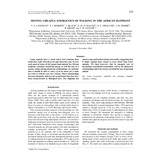| dc.contributor.author | Langman, TJ | |
| dc.contributor.author | Roberts, J | |
| dc.contributor.author | Maloiy, GMO | |
| dc.contributor.author | Heglund, NC | |
| dc.contributor.author | Weber, JM | |
| dc.contributor.author | Kram, R | |
| dc.contributor.author | Taylor, CR | |
| dc.date.accessioned | 2013-05-16T07:21:00Z | |
| dc.date.available | 2013-05-16T07:21:00Z | |
| dc.date.issued | 1995 | |
| dc.identifier.citation | The Journal of Experimental Biology 198, 629–632 (1995) | en |
| dc.identifier.uri | http://erepository.uonbi.ac.ke:8080/xmlui/handle/123456789/23494 | |
| dc.description.abstract | Large animals have a much better fuel economy than
small ones, both when they rest and when they run. At rest,
each gram of tissue of the largest land animal, the African
elephant, consumes metabolic energy at 1/20 the rate of a
mouse; using existing allometric relationships, we calculate
that it should be able to carry 1 g of its tissue (or a load)
for 1 km at 1/40 the cost for a mouse. These relationships
between energetics and size are so consistent that they have
been characterized as biological laws. The elephant has
massive legs and lumbers along awkwardly, suggesting that
it might expend more energy to move about than other
animals. We find, however, that its energetic cost of
locomotion is predicted remarkably well by the allometric
relationships and is the lowest recorded for any living land
animal. | en |
| dc.language.iso | en | en |
| dc.subject | Locomotion | en |
| dc.subject | Metabolic rate | en |
| dc.subject | Allometry | en |
| dc.subject | Elephant | en |
| dc.subject | Energetics | en |
| dc.subject | Walking | en |
| dc.title | Moving cheaply: energetics of walking in the african elephant | en |
| dc.type | Article | en |
| local.publisher | Institute of Animal Physiology and Biotechnology Research | en |
| local.publisher | Department of Biology, Louisiana State University | en |
| local.publisher | Department of Biology, University of Ottawa | en |

